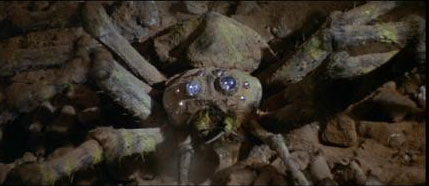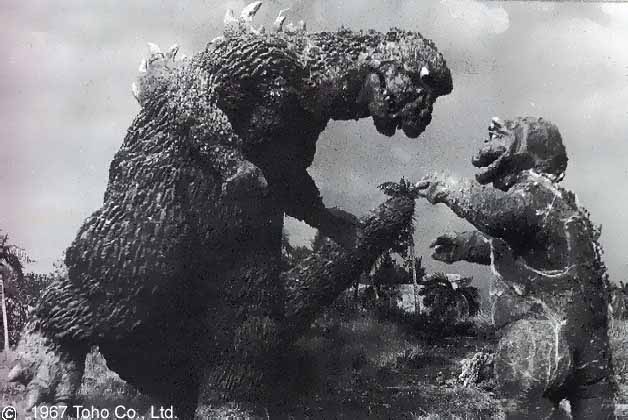 This film is from the goofy era when Godzilla was mutating from a radioactive menace into a lovable hero. The tone is definitely geared for younger viewers, and it’s impossible to take the proceedings seriously. And yet, SON OF GODZILLA is actually quite entertaining on its own juvenile level, filled with strong performances, exotic locations shooting, colorful special effects, enjoyable music, lots of action, and plenty of laughs.
This film is from the goofy era when Godzilla was mutating from a radioactive menace into a lovable hero. The tone is definitely geared for younger viewers, and it’s impossible to take the proceedings seriously. And yet, SON OF GODZILLA is actually quite entertaining on its own juvenile level, filled with strong performances, exotic locations shooting, colorful special effects, enjoyable music, lots of action, and plenty of laughs.
The story focuses on a group of scientists conducting experiments on an isolated South Seas island. Their initial test (an attempt to change weather) runs afoul of unexpected high-frequency interference – which turns out to be a telepathic cry for help from a mysterious egg that is unearthed by a group of giant preying mantises. The botched test creates a torrential downpour of contaminated rain that somehow enlarges the preying mantises even further. They break open the egg, revealing a baby Godzilla, but before they can kill it, the elder Godzilla arrives, responding to the signal that ruined the test. The scientists, along with a reporter who parachutes in, looking for a story, and an orphaned island girl, try to finish their experiments in spite of the monsters; the girl even feeds coconuts to the baby Godzilla, named Minya. But then things really get bad: a giant spider emerges from its rocky lair and engages in a life-or-death battle with the father-and-son dinosaurs. The scientists launch another test just before escaping on the life raft. As Godzilla and Minya finish off the spider, the test reverses the sweltering tropical temperature, resulting snowfall on the island. As a submarine surfaces to rescue the scientists, they see Godzilla and Minya huddle together, going into hibernation in the freezing cold.
Unlike the previous entry in the series, GODZILLA VS THE SEA MONSTER, which asked you to check your brain at the door and enjoy a spy-movie-action no-brainer, SON OF GODZILLA only asks that you enjoy the film as fun-filled family entertainment. The image of Godzilla as paternal protector is completely at odds with the monster’s radioactive origins, but if you can jump that mental hurdle, SON OF GODZILLA is actually quite a bit better than its most obvious equivalent, the silly SON OF KONG (1933).
SON OF GODZILLA’s light-hearted tone is underlined by the music of Masuro Sato (who had previously scored GODZILLA VS. THE SEA MONSTER). His jazzy, upbeat themes suggest a cool ’60s action flick, abandoning the ponderous, serious tone of Akira Ifukube, who had scored most of the previous Godzilla films. Likewise, director Jun Fukuda goes for a fast-pace, with an emphasis on the entertaining action rather than sober scares. This approach, combined with colorful production design, creates a sort of artificial movie atmosphere that is almost the cinematic equivalent of a comic book – it’s fun to look at, even if you don’t believe it.
The special effects are a step up from the previous film. At a time when Toho studios was shaving budgets by moving away from expensive composite photography, the film is filled with special effects shots that combine live-action with the miniature monsters to great effect. The work may not be convincing (in fact, wires are often visible operating the mantises and the spider, which are large marionettes, not actors in suits), but it does establish a style that becomes its own justification, creating not a picture of reality but a make-believe world filled with scary dangers (scary to kids, that is). Special effects director Sadamasa Arikawa (taking over for Eija Tsuburaya, who had moved on to television work on series like ULTRAMAN) expertly choreographs the monster actions and battles – the movements of the giant mantis and spider that Godzilla fights are all impressive.
 The design work for the insects and the arachnid are quite good. Unfortunately, the younger Godzilla looks nothing like his famous parent: he’s roly-poly and cute – obviously designed to enchant kids. Even worse, the Godzilla suit in this film is infamous among fans for being one of the worst in the series—with big white eyes that give a Muppet-type look to the king of the monsters, apparently in an attempt to make him more human and likable. Even with these changes, there is little resemblance to his son, who is mostly used to comic effect.
The design work for the insects and the arachnid are quite good. Unfortunately, the younger Godzilla looks nothing like his famous parent: he’s roly-poly and cute – obviously designed to enchant kids. Even worse, the Godzilla suit in this film is infamous among fans for being one of the worst in the series—with big white eyes that give a Muppet-type look to the king of the monsters, apparently in an attempt to make him more human and likable. Even with these changes, there is little resemblance to his son, who is mostly used to comic effect.
Strangely, the film remains enjoyable in spite of its problems. By this time in the series, the serious science-fiction trappings of 1954’s GOJIRA had long been abandoned in favor of a fantasy approach. However, if you’re willing to suspend disbelief, the results are amusing. This is definitely a camp movie, but a thoroughly enjoyable one, and the scene of Godzilla and son going into hibernation together as the snow covers them is surprisingly effective.
FAVORITE SCENES
At one point, Godzilla attempts to teach Minya to use his radioactive breath, but the poor little tyke only blows smoke rings – until the angry parent stomps on his tail, causing the youngster to spew the desire radioactive halitosis. Shortly thereafter, Godzilla takes a nap, and Minya plays jump rope over his twitching tail!
In one excellent shot (beautiful to behold on a cinemascope movie screen), the live actors take cover behind a metalic structure in the foreground, while the giant spider walks from left to right through the miniature jungle in the background. The action is perfectly timed, the blend of full-scale and miniature elements is convincing, and the movement of the spider is perfect.
TRIVIA
Haruo Nakajima, the man inside the Godzilla suit throughout the 1950s, 1960s, and into the ’70s, gets a rare screen credit for his performance in SON OF GODZILLA. Ironically, he is not in much of the film, appearing only in those scenes wherein Godzilla is seen rising out of the ocean near the beginning. (The old Godzilla suit seen in previous films was resued for this scene.) All of Godzilla’s scenes on land are performed by Seiji Onaka, a taller actor, in a new suit made to look less threatening. The reason for the casting change is that the titular Son of Godzilla is performed by a midget wrestler (“Little Man” Marchan), and it was necessary to get a taller actor in the Godzilla suit, so that there would be a greater distinction in height between Godzilla and his son.
This is the first film to use the phrase “Monster Island,” although in this case it is casually tossed off by a reporter to describe the fact that the tropical island is inhabited by a handful of monsters (giant preying mantises, a giant spider). In subsequent Toho films, Monster Island would specifically refer to an island where the the entire pantheon of monsters from previous films (Rodan, Mothra, etc) were gathered together.
On the original Japanese-language soundtrack, the spider is called Kumonga, and the giant mantises are called Karakuras. For the English-dubbed version, the monster’s names were changed to, respectively, Spiga and Gimantis.
SON OF GODZILLA (Kaijuto No Kessen: Gojira No Musuko[ “Monster Island’s Decisive Battle: Godzilla’s Son”]1967). Directed by Jun Fukuda. Written by Shinichi Sekizawa, Kazue Shiba. Cast: Tadao Takashim, Akira Kubo, Bibari Maeda, Akihiko HIrata, Yoshio Tsuchiya, Kenji Sahara, Kenichiro Maruyama, Seishiro Kuno, Seiji Onaka, Haruo Nakajima, “Little Man” Marchan.
